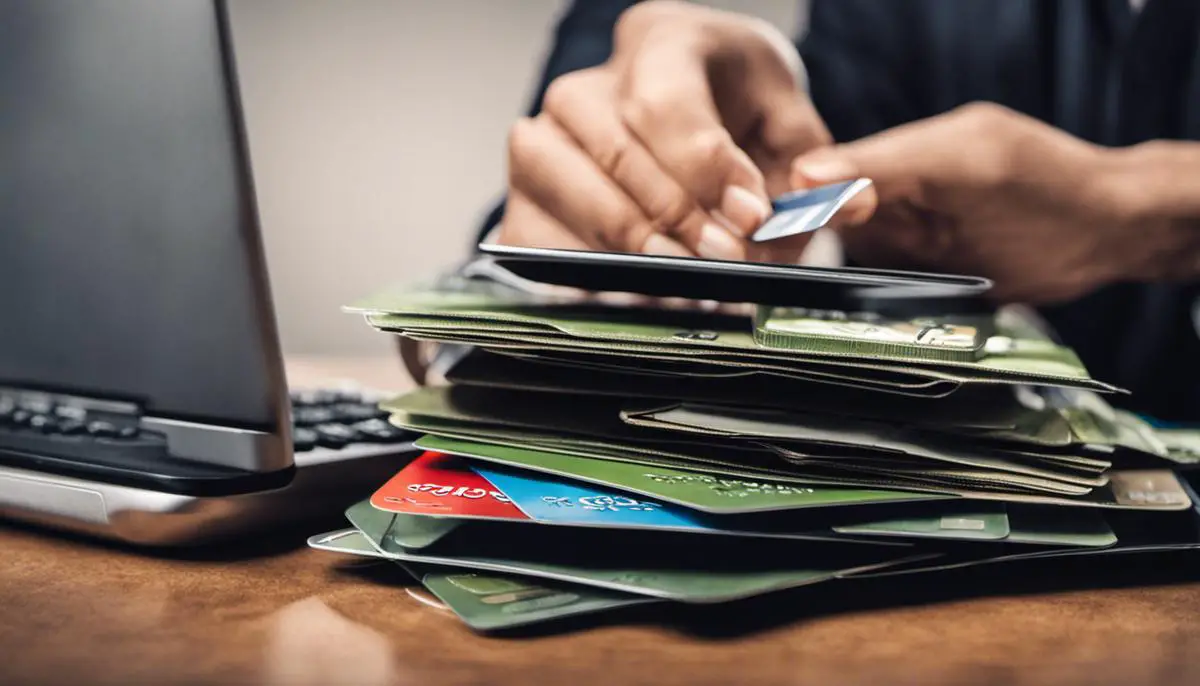In today’s modern economy, credit card debt is a reality for many Americans. It’s a complex issue. Credit card debt relief often starts subtly but can accrue to towering heights if left unchecked. Understanding the mechanics of how credit card debt builds, recognizing its causes and potential consequences, and arming oneself with strategies for managing and reducing this type of debt can contribute significantly to one’s overall financial wellness. Through enhanced knowledge, sound financial strategies, and utilization of available resources, anyone can navigate the labyrinth of credit card debt and discover a path to financial freedom.

Understanding Credit Card Debt
Understanding Credit Card Debt and How it Accrues
Credit card debt refers to the money that you owe to your credit card company. It’s important to understand the details associated with credit card debt, as it significantly affects your financial health. Each time you make a purchase using your credit card, you are borrowing money from the lender with a contractual agreement that you would repay the debt.
Also, it’s not just the charges for the purchases that add up your debt, but also several other charges such as late fees, annual fees, and cash advance fees. Yes, there are ways to pay these charges through a mobile credit card login with your credit card company, but you need money to do so.
If you end up not paying the total outstanding amount by the due date, interest begins to accrue on the remaining balance – this is known as carrying a balance.
The Crucial Role of Interest Rates and Minimum Payments
Interest rates, also known as the APR – Annual Percentage Rate, play a crucial role in the accumulation of credit card debt. Your credit card agreement sets an interest rate, which is the price you pay for borrowing money. Credit card interest rates are typically quite high, and if not managed properly, the debt can quickly spiral out of control.
In addition to accruing interest, credit card companies require cardholders to make a minimum payment each month. This is the smallest amount you can pay on your credit card bill to keep your account in good standing. However, only making the minimum payment can result in the buildup of substantial interest over time as it barely covers the interest owed, let alone the principal amount.
Impact of Credit Card Debt on Personal Finance
Credit card debt can have several repercussions on personal finance. Firstly, carrying high credit card balances can negatively affect your credit score. A higher credit utilization rate, i.e., the ratio of your credit card balance to your credit limit, may lower your credit score. In turn, a low credit score can make it difficult for you to secure loans or get good interest rates in the future.
Secondly, credit card debt is ‘expensive’ debt due to the high-interest rates. The longer you take to repay, the more interest you incur. Eventually, the accumulated debt can become a significant burden, making it difficult for you to meet your daily financial needs or save up for future goals. It’s also worth noting that failing to make the minimum payment by the due date can lead to late payment fees, increasing your debt and potentially damaging your credit score further.
Understanding Credit Card Debt
Understanding credit card debt can feel overwhelming, but it doesn’t have to be. By learning how credit card debt accumulates, the function of interest rates, the implications of minimum payments, and their impacts on your personal finances, you are equipping yourself to make more informed and strategic fiscal decisions. This knowledge can be hugely beneficial in your journey to effectively managing and paying off your debt.

Causes and Consequences of Credit Card Debt
Recognizing The Main Causes of Credit Card Debt
Many elements contribute to credit card debt, ranging from poor financial management to impulsive purchasing. A widespread issue is that individuals often exceed their earnings with their expenditure, mostly on nonessentials. Regular spending beyond one’s means can establish an ongoing cycle of debt, especially if credit cards are regularly used to cover day-to-day expenses or support a lifestyle that is not financially sustainable.
Another significant factor leading to credit card debt is the absence of a budget or financial forecast. Without a comprehensive understanding of income versus expenses, it becomes all too easy to live beyond one’s means. This circumstance can increase dependency on credit, which in turn accelerates debt accumulation.
Sometimes life throws unexpected curveballs which can also contribute to growing credit card debt. Unanticipated costs like medical expenses, car repairs, or sudden loss of income can force those without sufficient savings to turn to credit cards to manage these expenses.
Consequences of Accumulating Credit Card Debt
The ramifications of accruing credit card debt are often monumental and can significantly impact an individual’s overall financial health and well-being. One of the most immediate consequences is a decreased credit score. A high balance on credit cards can lead to higher credit utilization, which negatively impacts the credit score. Lower credit scores can affect one’s ability to secure future credit or loans and may also lead to higher interest rates on those loans.
Accumulated credit card debt also increases the individual’s financial burden. High-interest rates coupled with the capital amount of debt can quickly grow, making it challenging to pay off. This burgeoning debt, if left unchecked, can consume a substantial portion of the individual’s income, leaving less money for other financial goals or basic needs.
Another less tangible but equally important consequence of credit card debt is the heightened stress it can cause. The constant worry about debt repayment can lead to mental and physical health issues, including anxiety, insomnia, and other stress-related ailments.
In worst-case scenarios, uncontrolled credit card debt can lead to bankruptcy. When the debt becomes unmanageable and the individual is unable to make necessary payments, filing for bankruptcy may be the only solution. However, bankruptcy can severely damage one’s credit history and make it difficult to secure credit for many years.
Credit Card Debt Assistance
Addressing credit card debt is typically a process that begins when you recognize the issue and seek relevant advice. Recourses like debt management plans provided by credit counseling agencies can be instrumental in assisting individuals to reclaim their fiscal stability. Similarly, options such as debt consolidation loans or balance transfers can facilitate easier repayment avenues and potentially reduce the accrued interest.
For some, it might be worthwhile to explore debt settlement, an approach where the creditor agrees to a repayment amount less than the actual debt. However, it’s important to note that this could negatively affect your credit rating. Hence, it is imperative to assess all potential solutions and consult with a financial advisor or credit counselor to figure out your best strategy to tackle the credit card debt.
Bear in mind, financial literacy is the backbone of both preventing and managing credit card debt. By comprehending the terms and conditions of your credit card, spending wisely, and devising a comprehensive financial strategy, you can contribute significantly towards leading a debt-free life.

Strategies to Manage and Reduce Credit Card Debt
Demystifying Credit Card Debt
Neglecting the management of credit card debts may lead to its rapid accumulation, potentially plunging you into severe financial hardship. By familiarizing yourself with diverse approaches towards managing and lowering this kind of debt, you can carve out a suitable plan to retake the reins of your financial health.
Debt Snowball Method
The debt snowball method is one effective strategy for managing credit card debt. It involves paying off your smallest debts first while maintaining minimum payments on larger debts. As you pay off each debt, your monthly disposable income increases, allowing you to pay off the next smallest debt more quickly. Over time, you create a “snowball” effect.
The primary advantage of this strategy is the psychological boost it provides by allowing you to see progress as you eliminate smaller debts. However, it can result in paying more in interest over time since larger debts (which might have higher interest rates) are left for later.
Debt Avalanche Method
The debt avalanche method, on the other hand, focuses on paying off debts with the highest interest rates first. This method can be more efficient and cost-effective over the long-term as it reduces the total amount of interest you pay.
However, some individuals may find this strategy challenging to stick to, as progress may seem slower than the debt snowball method since larger debts are targeted first.
Debt Consolidation
Debt consolidation is another method to manage credit card debt. It involves taking out a single loan to pay off multiple debts, hence leaving you with just one debt payment each month. This method can simplify repayment and potentially lower the amount of interest you’re paying.
The downside to this strategy is that it often requires a good credit score to get a consolidation loan at a competitively low interest rate. Furthermore, if the root cause of the debt isn’t addressed, there’s a risk of running up credit card balances again after they’ve been paid off by the consolidation loan.
Balance Transfers
A balance transfer involves moving your debt from a card with a high-interest rate to one with a lower interest rate (often a promotional rate), which can reduce interest expenses and accelerate debt repayment.
This strategy can be effective, but there are several considerations. Often balance transfers come with fees, and the low-interest rate only applies for a fixed period. If you can’t pay off the balance in that period, you could face a higher interest rate afterward. It’s crucial to carefully read the terms and conditions of the balance transfer offer before proceeding.
Understanding various strategies to handle and lower credit card debt is key, each carrying its own benefits and disadvantages. Careful consideration of these strategies, and possibly consulting with a financial expert, can help identify the solution best tailored to your individual needs. Regular financial assessments and budgeting are also fundamental elements in mastering your credit card debt.
A significant thing to bear in mind is that escaping debt usually involves a gradual, stepped process, necessitating patience, self-discipline and possibly modifications to your lifestyle. It may be challenging, but with the correct plan and a commitment to stick to it, a debt-free future is within your reach.

Resources for Credit Card Debt Help
While there are many alternatives to credit cards for making purchases, some of the best advice can come not in the form of credit cards. There are many services available for credit card debt relief that can turn your financial situation around.
Navigating Credit Card Debt with Credit Counseling Services
Individuals wrestling with credit card debt can turn to credit counseling services. These non-profit organizations provide education, assist with budgeting and establish individualized debt management programs. They are certified by the National Foundation for Credit Counseling (NFCC) or the Financial Counseling Association of America (FCAA). They assist individuals in appreciating their debt situation and supply options to mitigate it. One of the crucial facets of these services is their commitment to instill financial management skills to ward off the engendering of future debt.
Credit Card Debt Relief Programs: Saviors for Drowning Debtors
Debt relief programs offer another route for those struggling to keep pace with mounting credit card debts. These programs negotiate with credit card companies to reduce the amount you owe, making it easier to pay off your debt. They can consolidate multiple debts into one, resulting in a single monthly payment with lower interest. However, it’s essential to be cautious, as not all debt relief services are reputable. The Federal Trade Commission (FTC) advises individuals to research multiple options and weigh the potential risks against benefits before proceeding.
Legal Options: The Last Resort
For those severely stricken by credit card debt, there are legal options available such as bankruptcy. While this can alleviate immediate financial strain, it also has lasting implications on one’s credit score and ability to secure loans in the future. Bankruptcy should be considered only after exploring all other options and consultation with a financial expert.
Beware of Scams: Not All Helpers Are Saviors
Unfortunately, desperation to escape debt can make individuals more susceptible to scams. An initial red flag can be upfront fees, as legitimate credit counseling agencies typically offer free initial consultations. Additionally, vague guarantees to wipe out credit card debts, cease all debt collection calls, and improve credit scores may also hint at a potential scam. Always remember to research a company thoroughly before signing any contracts or making payments. The FTC and Better Business Bureau provide resources to verify the credibility of these companies.

It’s crucial to remember that reducing credit card debt is often a slow process, requiring commitment and patience to come out on the other side. There is no one-size-fits-all solution, each individual’s circumstances will dictate which options are most suitable. Therefore, personal research and a comprehensive understanding of all options, combined with expert advice when necessary, can pave the way towards becoming debt-free.
The journey towards minimizing credit card debt and improving one’s financial situation is not always straightforward. However, the availability of various strategies and numerous resources provide a beneficial road map for those struggling with credit card debt. Coupled with enhanced financial knowledge and determination, there is always a way out of debt. One must decide the best path for them, be it debt snowball and avalanche methods, consolidation, or balance transfers and work steadfastly toward debt reduction. By adopting proactive measures and seeking help when needed, financial freedom is achievable, ultimately resulting in less stress and a more stable financial future.



